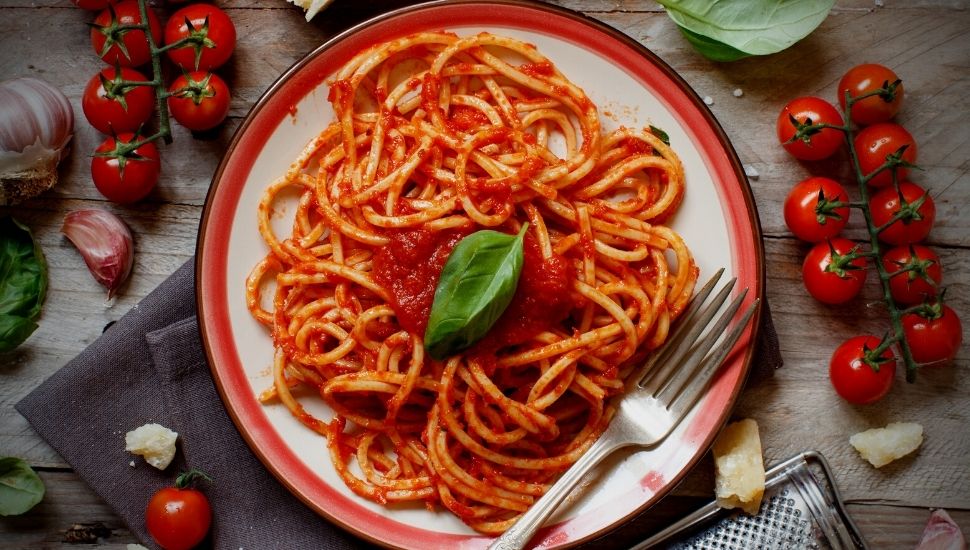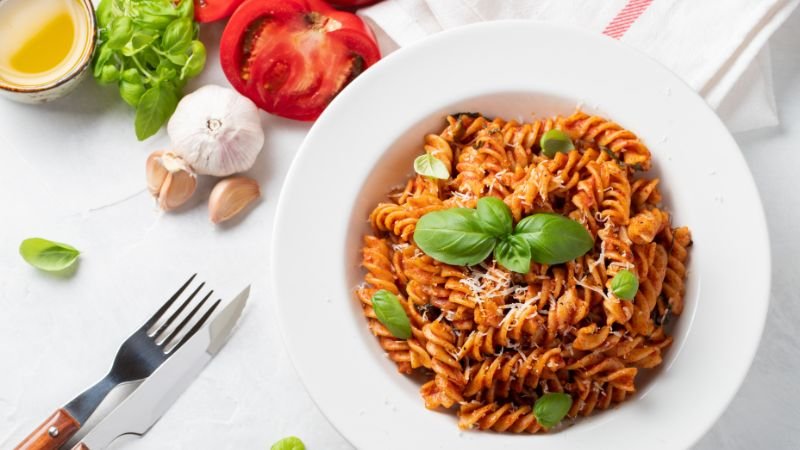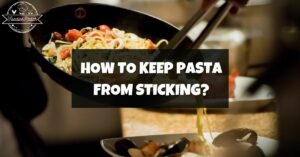
We can all make pasta. The dried pasta is placed in a saucepan of boiling water, cooked for 8 to 12 minutes, and then removed.
Can you cook dried pasta except for the traditional method, which is very simple if you know what you’re doing? Fortunately, there is still another original, unconventional method of cooking pasta.
You may have wondered if you can cook pasta with sauce rather than boiling it in a big pot of water, as many people do.
You might also have queries like what is the optimal way to prepare pasta or can cooking pasta with sauce alter its flavor? The secret is to cook your pasta in the sauce itself.
You can create an easy and delectable one-pot meal by mixing uncooked pasta and a little extra liquid into the sauce. It may sound strange, but it works! Don’t worry, as we have got you covered.
Is it possible to prepare pasta with sauce?
Yes, you can cook pasta in the sauce. When you cook your pasta in the sauce, you’ll save time, make less mess, and clean up less, but each noodle will absorb more spice for a more intense flavor.
We understand that you might be a little wary if this is something you have yet to hear. For some Italians, boiling pasta straight in the sauce is offensive.
The following are some advantages of cooking pasta in the sauce:
- Saving time
- Cleaning is quicker and simpler.
- You increase the flavor.
- The inherent starch in the pasta thickens everything up naturally.
We fully encourage your desire to produce the ideal authentic Italian pasta if you have the time. Making the sauce and the pasta from scratch is what we’re discussing.
Which Is Better: Homemade Pasta Sauce Or Store-bought?
Utilizing pasta sauce from the store is reasonably practical. Given that you can microwave the sauce and then immediately pour it over your pasta, you can have dinner ready in minutes.
The unpleasant reality is that You are putting things into your body that you have no idea about. No matter how much you attempt to dress it up, it doesn’t taste like a flavorful homemade sauce.
It’s okay to be Jamie Oliver to recognize when someone has used a jar of premade pasta sauce. Your health is being sacrificed for convenience.

Making your sauce is always preferable for this reason. You’ll consume a healthier dinner, use less salt, sugar, and fat, and be fully aware of what you’re consuming.
When preparing your pasta sauce, several recipes advise using canned tomatoes. The problem is that they each have unique issues.
The majority of individuals are aware that BPA is unhealthy. In a research by the Centers for Disease Control and Prevention, nearly all 2 517 participants had evidence of BPA in their urine.
Does Cooking Pasta In The Sauce Alter The Flavor?
There is a way to enhance the flavor of your pasta significantly. And modifying how the sauce reacts with the pasta is all necessary.
What comes first, pasta in sauce or sauce in pasta? It may sound foolish to people who work as experienced pasta chefs.
This simple approach will turn your pasta bowl around, and you’ll thank us afterward. The pasta will cool down and solidify if you put it directly on a platter. It couldn’t take the flavor from the sauce.

To obtain maximum flavor absorption and even flavor distribution across the entire dish, pasta is added to the sauce.
Additionally, serving pasta without sauce will result in it becoming dry. You would need to smear it in butter or oil to keep it fresh. As a result, you will alter the recipe and include extra fats.
Pasta combined with spicy sauce is the ideal method for accomplishing this (turn off the heat). Make sure to thoroughly coat the pasta as you toss it in the sauce for a couple of minutes.
How Should Pasta Be Prepared For Optimal Taste?
This manual will show you how to prepare pasta to perfection. Although boiling water is necessary to prepare pasta, proper pasta preparation requires close attention to detail.
Understanding a few of the hows and whys of cooking pasta may help your pasta meal turn out at its finest.
#1: Bring 5 quarts of water to a rolling boil for every pound of pasta. You should add salt to boiling water.
For every 5 quarts of water, add around two teaspoons of coarse sea salt. But kindly avoid adding oil! Never be reluctant to salt the pasta water.
#2: To prevent the pasta from sticking, add and toss it. Within the first two minutes of pasta cooking, stir. Before the starches are released into the water, they will likely clump together initially.
#3: Verify if the pasta is al dente: two to three minutes before the pasta’s cook time. With a speck of white in the middle, this texture is characterized as soft with a hard bite. The pasta’s soul is referred to as this. To be specific, taste.
#4: Remove 1 cup of the pasta cooking water once the pasta is finished cooking and turn off the heat.
This water you used to pour down the drain but seems soupy is a miracle cure! Essential starch can be found in the reserved pasta water, which can be used later to dilute or thicken your sauce.
#5: Pour the pasta into a colander in the sink and drain it quickly and loosely. The noodles ought to be moist. However, avoid rinsing the pasta.
Rinsing pasta will chill it and stop your sauce from absorbing into it. The carbohydrate in the water makes the sauce stick to your pasta.
You should rinse your pasta when using it in a cold meal, such as a pasta salad. Rinsing the pasta can assist in stopping the cooking process in situations like those.
#6: Combine pasta with the prepared sauce in a warm saucepan. To blend flavors, cook pasta with sauce for around 2 minutes. It’s now ready for serving! That is the ideal way to prepare pasta.
When Is It Not Recommended To Cook Pasta In The Sauce?
Since most pasta dishes can be prepared with the sauce already added, we should focus on situations where this is typically not permitted or advised.
- If the pasta is long
Long, dry pasta, like spaghetti or linguine, will cook well in the sauce if you have a large pot. Otherwise, your pasta will be extremely unevenly cooked as most of the pasta will be sticking out of the pan.
Long pasta can only be cooked effectively by being cut in half or thirds, but doing so eliminates the appeal of eating long pasta.
- If You Mind a “Starchy” Taste
You should be able to detect the starch because the pasta releases it into the sauce. Even though starch is usually undetectable, a lot of it will give the food a taste that is distinct from usual.
While some people enjoy the starchy flavor, you should avoid using this technique if you don’t.
- When You Need Pasta Quick
If you’re searching for a quick meal, you should only attempt to make it in a sauce if it takes longer.
Boil the pasta in water and top it with a prepared sauce if you only have a short amount of time (it doesn’t usually take that long), and you’ll have it in about 15 minutes.
Final Verdict:
It remains to be seen if preparing pasta in the sauce will become a regular practice in your home. You might find it fascinating enough to attempt it, and perhaps it’s something you’d like to improve over time.
The most important lesson here is to add water carefully and in small amounts to avoid diluting your food. Also, make sure you are not in a hurry to cook pasta.
Paying attention to the type of pasta and sauce is essential. You will also need to clean fewer utensils.







